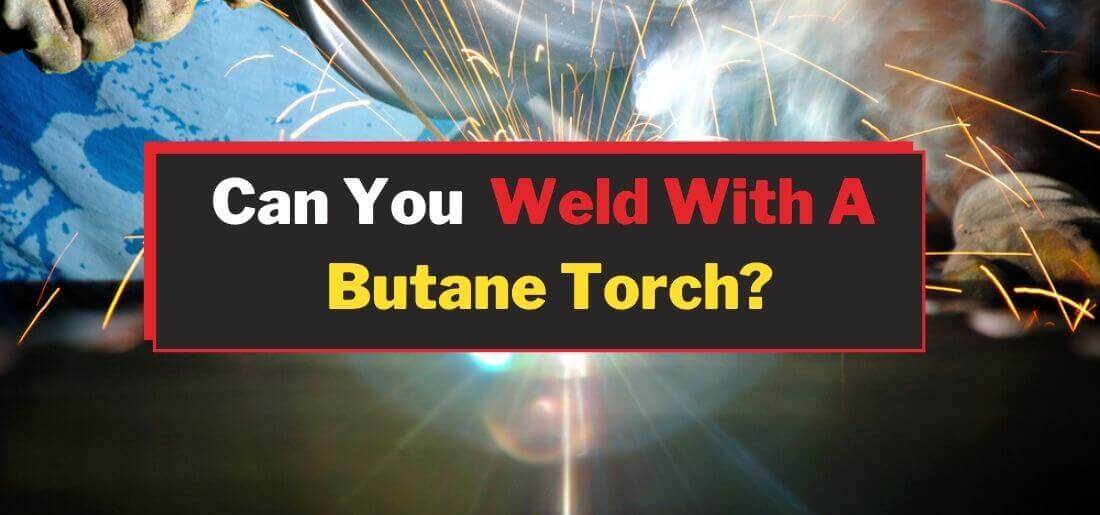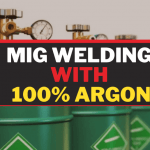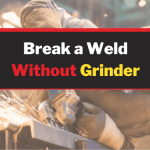You must have a small butane torch in your garage. It’s a small torch that creates intense fiery flames with the help of Butane Fuel. It’s like a small lighter and it has sufficient capacity to work efficiently, but is it totally workable in welding work? A usual welding torch differs from Butane Torch, and it’s specifically constructed for welding. But in sudden emergencies, can you use a Butane Torch for welding?
The answer is no, you can’t use it. Because a butane torch doesn’t hold enough power to create the sufficient energy level required for welding. Results in not melting the base metals, which is the important factor in welding. That’s why it isn’t considered a useful tool.
But apart from welding, you can use this little torch for other purposes. Don’t be concerned and read further why it’s not a good idea to use it in welding and other particular ways you can use Butane Torch.
What Is Butane Torch?
A butane torch is usually called a micro torch. They’re minor blow torches that can be held easily in hands. The spectacular thing about these torches is they’re simply comfortable in hands and simple to use.
They have a small Tank Of Butane Fuel, which is easily refillable. This fuel uses the air oxygen to keep the flame burning constantly.
The major reason to not use these blowtorches in welding is it produces the least amount of heat. Its average temperature is around 2400°. The best thing about Butane Torch is its pinpointing flame. Its open tip keeps the flame pinpointed to the specific area you’re working on, making things effortlessly clear.
You can further control the heat by adjusting the torch closure to the object or just further away. Another significant benefit includes inexpensive cost, Butane Torches are easy to find and easiest to use. People often use these blowtorches in plumbing work and making jewelry.
Related Article: Can I Weld Aluminum With A Stick Welder?
Why Can’t You Weld With Butane Torch?
The welding procedure comprises heating two metal pieces to melt them, not entirely but to some level. When they begin to melt, they again join for a stable and strong joint between them. Here are a few reasons why Butane Torch can’t be used in welding work.
Produces Low Heat
The low temperature of the butane torch is the major reason for its unimpressive work in welding. In welding, the average temperature used is approximately 3200°. If you heat the metal with Butane Torch, the metal won’t reach the required temperature, it will need to join together.
Not Powerful
The small-sized torch doesn’t hold enough power to heat the metal sufficiently. Its handy size prevents it from being a powerful heating element for welding purposes. Apart from providing pinpoint heat, the low power behind the flame doesn’t let it work properly.
Tiny Fuel Reserve
Since a butane torch is its fuel canister is tiny. That’s why it doesn’t hold enough fuel to light the flame for the required period. Whenever you light up the torch to heat metal, fuel will be gone during the welding procedure. You’ll have to stop welding and refill the canister, but the heated metal will cool down again.
Now you must have understood why Butane Torch is not recommended for welding work. But don’t worry, we won’t let your money get wasted, we’ve come up with some effective ways with which you can use a butane torch. Two famous ways are Brazing And Soldering. Read further to know about how to put this blowtorch in work.
How To Braze With A Butane Torch?
It’s a metal joining procedure that compromises joining two metals by filling the space with metal filler. Different from welding, brazing doesn’t require high-temperature heating. That’s why Butane Torch is an ideal and handy option for brazing.
But remember brazing of heavy objects might be hectic and time-consuming with a butane torch. It’s recommended to use low heating material like copper for breezing.
How To Braze
- Scratch the surface of the material with the help of a wire brush or emery cloth.
- Now, clean up the material with some soap and water.
- Keep your materials in a specific position and clamp them.
- Place the butane torch to the point where metals meet until they glow.
- Here comes the part of the rod filler, place it between the joints. Don’t forget to pinpoint the constant heat of the joint.
- When metals become joined, clean off the excess residue on the joint with Wire Brush.
- Don’t rush things, if metals are large, work on a particular area at once.
Do you know brazing is beneficial than welding in many aspects? Welding and brazing, both keep the joint strong and healthy. We can’t underestimate brazing just because of low heat and the use of filler metal. Here are some advantages of brazing.
Prevents Distortion In Base Materials
The lower temperature of the butane torch prevents distortion in base metals during the brazing procedure. In welding, metal bases lose their strong integrity because of high temperatures. Whereas in brazing the joints remain solid with no metal melting.
Joint Look Better
Since you haven’t melted the metals, they look much better than welding work. The filler metal between base metals does the job perfectly rather than melting and joining the metals. Results in a smoother surface with zero effects of welding.
Easier Process
The major reason to consider brazing over welding is its Easier Process. Brazing is easy to learn and efficient to do on metals. If you’re new to brazing, you’ll most likely spend some hours learning this skill. It requires less time and less precision than welding. Plus, it’s a handy tool that makes the holding and heating procedure impressively simple.
Also Read: How To Break A Weld Without A Grinder?
How To Solder Jewelry With A Butane Torch?
Soldering is also a joining process. In the jewelry world, it’s quite famous. Here comes the role of Butane Torch, especially in making fine details on jewelry. Soldering silver and copper with a butane torch is fundamental, as they’re low heated metals.
Keep your jewelry pieces in a perfect place before you solder them.
- If you want smooth results with no distortion, consider positioning the joints with the help of clamps. It’s the first and crucial step in soldering jewelry.
- Take your butane torch to pinpoint the heat to the solder at the specific joint, move around the torch to conduct temperature evenly.
- When you’re done with soldering, soak the soldered jewelry in water for some time. Once it has cooled down completely, take the jewelry out of the water.
- It’s better if you clean the joints with sandpaper. Now you’re done with soldering jewelry.
A butane torch is a great and renowned tool in the jewelry-making world. Many famous artists swear by this small blowtorch’s excellent functionality. Apart from soldering and brazing, a butane torch is essential for closing jump rings and annealing metals. That’s why you shouldn’t judge this small blowtorch by its small size and creating low heat temperature.
Use Butane Torch For Good Purposes
Welding work requires high temperature and tons of skills and dedication. Special equipment is compulsory in welding, and unfortunately, a butane torch is not one of those essential tools. It’s not a big deal. If you can’t use it in welding procedures there are numerous ways you can put the butane torch to efficient use.
Here are some beneficial uses for Butane Torch:
1- Cooking
It’s not wrong to call butane torch a Cooking Torch. You can use it to caramelize sugar, melt brown toppings and cheese on top or roast the vegetables.
2- Jewelry Making
Its adjuster level to change heat directions makes it an ideal tool for jewelry making. You can create delicate earrings, jump rings, and small links.
3- Brazing
Brazing is joining two metals with an essential metal filler. Since it doesn’t include melting at high temperatures, a butane torch is a perfect choice to go for.
4- Firing Metal Clay
Firing metal clay is an important procedure to evaporate excess water and binder. After this process, you’ll have pure Metal Clay Or Art Clay. A butane torch is a great way to get the firing metal clay done.
5- Soldering Pipes
Soldering pipes with a butane torch is a good solution to emergencies. With its tip, it pinpoints the heat to a particular joint and successfully solves the leakage problem.
Final Verdict
Surely you can’t use a butane torch for welding purposes, but keeping it in a small toolbox is an excellent idea to meet with emergencies. It’s a Beneficial Tool for home repairing and the outstanding thing is you can use it in the kitchen as well.
Brazing, jewelry making, and firing metal clay with a butane torch are other good options to consider. This small-sized blowtorch is a Great Package in itself.




